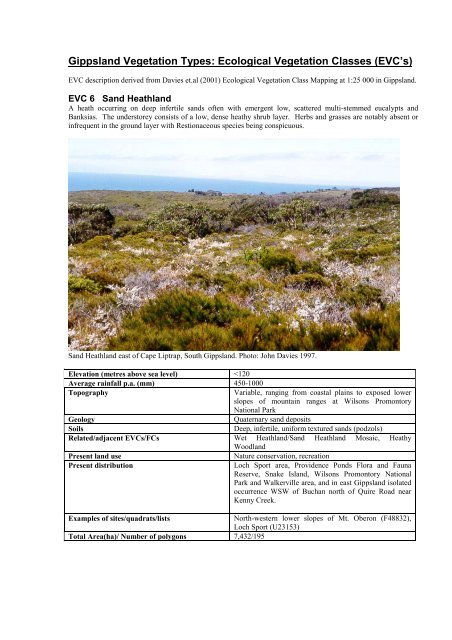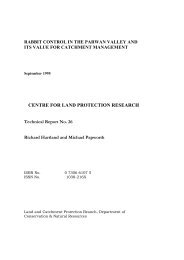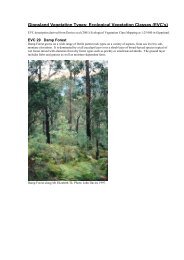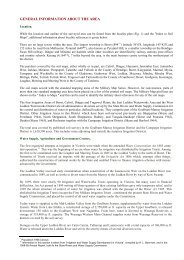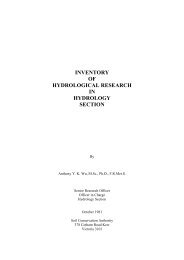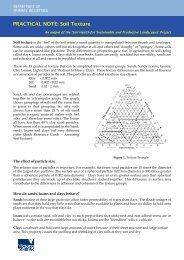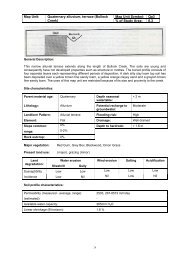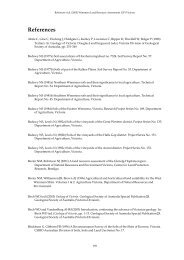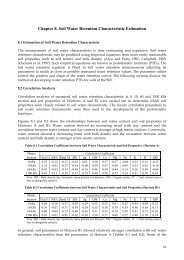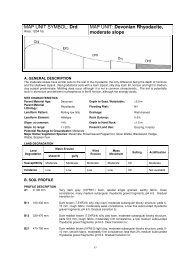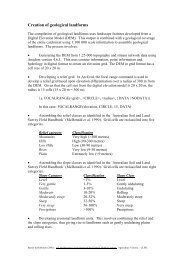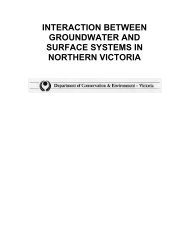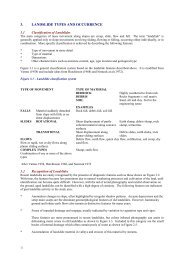EVC 6 Sand Heathland.pdf
EVC 6 Sand Heathland.pdf
EVC 6 Sand Heathland.pdf
You also want an ePaper? Increase the reach of your titles
YUMPU automatically turns print PDFs into web optimized ePapers that Google loves.
Gippsland Vegetation Types: Ecological Vegetation Classes (<strong>EVC</strong>’s)<br />
<strong>EVC</strong> description derived from Davies et.al (2001) Ecological Vegetation Class Mapping at 1:25 000 in Gippsland.<br />
<strong>EVC</strong> 6 <strong>Sand</strong> <strong>Heathland</strong><br />
A heath occurring on deep infertile sands often with emergent low, scattered multi-stemmed eucalypts and<br />
Banksias. The understorey consists of a low, dense heathy shrub layer. Herbs and grasses are notably absent or<br />
infrequent in the ground layer with Restionaceous species being conspicuous.<br />
<strong>Sand</strong> <strong>Heathland</strong> east of Cape Liptrap, South Gippsland. Photo: John Davies 1997.<br />
Elevation (metres above sea level)
Vegetation: structure/floristics:<br />
<strong>Sand</strong> <strong>Heathland</strong> is typically low in stature often with emergent scattered tall shrubs of Saw Banksia Banksia<br />
serrata and stunted mallee-like eucalypts such as Coast Manna Gum Eucalyptus viminalis subsp. pryoriana,<br />
Shining Peppermint E. willisii and Yertchuk Eucalyptus consideniana (Providence Ponds Flora and Fauna<br />
Reserve) usually dominating the landscape. The heathy understorey is dominated by the shrubs, Heath Tea-tree<br />
Leptospermum myrsinoides, Prickly Tea-tree L. continentale, Green She-oak Allocasuarina paradoxa, Bushy<br />
Needlewood Hakea decurrens (Waratah Bay and Wilsons Promontory) and Silver Banksia Banksia marginata. It<br />
also includes Common Heath Epacris impressa, Variable Bossiaea Bossiaea heterophylla, Showy Bossiaea B.<br />
cinerea, Smooth Parrot-pea Dillwynia glaberrima, Showy Parrot-pea D. sericea, Spike Wattle Acacia oxycedrus<br />
(notably absent from some areas), Prickly Broom-heath Monotoca scoparia, Broom Spurge Amperea xiphoclada<br />
var. xiphoclada, Sweet Wattle Acacia suaveolens, Common Beard-heath Leucopogon virgatus, Horny Cone-bush<br />
Isopogon ceratophyllus, Common Correa Correa reflexa and Common Wedge-pea Gompholobium huegelii.<br />
Austral Grass-tree Xanthorrhoea australis, Wattle Mat-rush Lomandra filiformis and Thick Twist-rush Caustis<br />
pentandra are often present.<br />
Herbs and grasses are notably absent or poorly represented. The ground cover is typically dominated by Tassel<br />
Rope-rush Hypolaena fastigiata and often includes <strong>Sand</strong>-hill Sword-sedge Lepidosperma concavum, Dwarf Wirelily<br />
Laxmannia orientalis, Tall Sundew Drosera peltata subsp. auriculata, Hairy Pink-bells Tetratheca pilosa,<br />
Prickly Guinea-flower H. acicularis, Milkmaids Burchardia umbellata and Honey-pots Acrotriche serrulata.<br />
In East Gippsland, <strong>Sand</strong> <strong>Heathland</strong> occurs only at Quire Road near Buchan. In contrast to most of its range where<br />
this <strong>EVC</strong> occurs near coastal vegetation on Quaternary aeolian sands, Quire Road is about 40km from the coast on<br />
siliceous sands derived from Tertiary outwash alluviums.<br />
In East Gippsland at Quire Road this <strong>EVC</strong> occurs as a low, open woodland of Shining Peppermint Eucalyptus<br />
willisii, with an understorey dominated by Austral Bracken Pteridium esculentum and Heath Tea-tree<br />
Leptospermum myrsinoides. A low shrubby ground layer of Common Aotus Aotus ericoides, Silver Banksia<br />
Banksia marginata and Prickly Broom-heath Monotoca scoparia are some of the plant species that occupy the<br />
gaps between the Austral Bracken.
Comments:<br />
Low height (often less than 5 m) of this <strong>EVC</strong> reflects the poor fertility and drought susceptibility of the sandy soil.<br />
Austral Bracken Pteridium esculentum is notably infrequent in <strong>Sand</strong> <strong>Heathland</strong> compared to the closely related<br />
group, Heathy Woodland.<br />
Gippsland species list including species frequency and fidelity.<br />
Fidelity:<br />
Rating of faithfulness of a species to an <strong>EVC</strong> or Floristic Community.<br />
Highest fidelity rating indicated by an “F” ie species only recorded in<br />
respective group.<br />
% Frequency: Percentage occurrence of a species/taxa in an <strong>EVC</strong> or Floristic<br />
Community – NB. Species highlighted in red are the most frequent and<br />
important.<br />
* = weeds ie: non native.<br />
Rarity categories from NRE’s Flora Information System (FIS).<br />
PROM. <strong>EVC</strong> 6: SAND HEATHLAND<br />
Species % Frequency Fidelity<br />
Drosera macrantha 42.86 F<br />
Tricoryne elatior 2.86 F<br />
Allocasuarina paradoxa 100.00 195.58<br />
Calytrix tetragona 31.43 184.49<br />
Tetratheca bauerifolia 68.57 57.49<br />
Prasophyllum elatum 8.57 50.34<br />
Lepidosperma semiteres 8.57 50.31<br />
Hibbertia fasciculata var. prostrata 28.57 27.95<br />
Isolepis marginata 11.43 22.36<br />
Drosera peltata ssp. auriculata 85.71 14.37<br />
Hibbertia virgata 8.57 12.58<br />
Rhytidosporum procumbens 25.71 11.61<br />
Pimelea humilis 34.29 11.18<br />
Opercularia varia 40.00 11.18<br />
Laxmannia orientalis 37.14 10.90<br />
Xanthosia dissecta 20.00 10.67<br />
Leucopogon virgatus 68.57 10.59<br />
Xanthosia tridentata 74.29 9.48<br />
Caesia parviflora 14.29 9.32<br />
Platysace heterophylla 34.29 8.39<br />
Hypolaena fastigiata 100.00 7.93<br />
Gompholobium huegelii 31.43 7.38<br />
Hibbertia procumbens 20.00 7.34<br />
Acacia suaveolens 45.71 6.71<br />
Bossiaea prostrata 5.71 6.70<br />
Viola sieberiana s.l. 5.71 6.70<br />
Hibbertia acicularis 51.43 6.56<br />
Xanthosia pusilla 62.86 6.36<br />
Dillwynia glaberrima 71.43 6.26<br />
Acianthus spp. 2.86 5.60<br />
Astroloma humifusum 20.00 5.59<br />
Monotoca scoparia 8.57 5.59<br />
Leptospermum myrsinoides 91.43 5.42<br />
Gonocarpus tetragynus 74.29 5.07<br />
Lepidosperma longitudinale 8.57 5.03<br />
Isopogon ceratophyllus 48.57 4.83<br />
Platylobium obtusangulum 71.43 4.71<br />
Patersonia glabrata 31.43 4.61<br />
Chrysocephalum apiculatum s.l. 11.43 4.47<br />
Lepidosperma concavum 77.14 4.44
Species % Frequency Fidelity<br />
Dillwynia sericea 17.14 4.19<br />
Lomandra filiformis 28.57 3.99<br />
Amperea xiphoclada var. xiphoclada 48.57 3.80<br />
Hakea decurrens 42.86 3.76<br />
Hakea ulicina 11.43 3.73<br />
Burchardia umbellata 34.29 3.59<br />
Leucopogon ericoides 2.86 3.36<br />
Comesperma calymega 2.86 3.36<br />
Tetrarrhena distichophylla 11.43 3.35<br />
Persoonia juniperina 11.43 3.35<br />
Acrotriche serrulata 48.57 3.35<br />
Patersonia fragilis 20.00 3.01<br />
Lepidosperma filiforme 28.57 2.66<br />
Pimelea linifolia 8.57 2.52<br />
Argentipallium obtusifolium 2.86 2.40<br />
Mitrasacme pilosa 5.71 2.39<br />
Cassytha glabella 62.86 2.38<br />
Epacris impressa 54.29 2.38<br />
Banksia marginata 45.71 1.92<br />
Lomandra longifolia 51.43 1.91<br />
Xanthorrhoea minor ssp. lutea 5.71 1.60<br />
Bossiaea cinerea 5.71 1.52<br />
Monotoca elliptica s.l. 8.57 1.40<br />
Banksia serrata 8.57 1.32<br />
Correa reflexa 20.00 1.32<br />
Leptocarpus tenax 20.00 1.22<br />
Xanthorrhoea australis 20.00 1.08<br />
Lindsaea linearis 14.29 1.05<br />
Leptospermum continentale 40.00 1.03<br />
Helichrysum scorpioides 5.71 1.02<br />
Spyridium parvifolium 8.57 0.99<br />
Kunzea ambigua 5.71 0.91<br />
Schoenus brevifolius 11.43 0.81<br />
Schoenus lepidosperma 5.71 0.80<br />
Leptospermum laevigatum 20.00 0.69<br />
Billardiera scandens var. scandens 5.71 0.59<br />
Epacris lanuginosa 2.86 0.49<br />
Sprengelia incarnata 5.71 0.43<br />
Banksia spinulosa var. cunninghamii 2.86 0.36<br />
Apodasmia brownii 2.86 0.33<br />
Hibbertia sericea s.l. 5.71 0.26<br />
Melaleuca squarrosa 5.71 0.23


